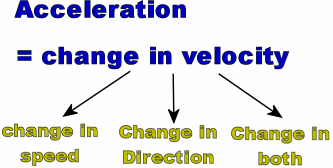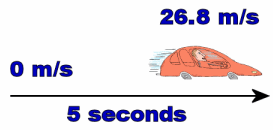Delta Documentation
Use the following document to complete the Delta Aircraft flight project.
Once completed your GROUP should submit the report to me - just submit one (1). Email the report to [email protected]
Delta Aircraft Document
Use the following document to complete the Delta Aircraft flight project.
Once completed your GROUP should submit the report to me - just submit one (1). Email the report to [email protected]
Delta Aircraft Document
|
We have discussed speed and velocity, now we are going to discuss acceleration. First of all, we are going to define what an acceleration often used in physics is and then we are going to discuss the acceleration formula.
Definition of Acceleration Acceleration is an expression of the change in the velocity of an object. Since the velocity has two component; speed and direction, the change can be in speed, direction or both speed and direction. Since the acceleration is defined as the change in velocity, the acceleration is a vector quantity (as opposed to a scalar quantity) meaning acceleration is directional. |

Notice that the unit for acceleration is meter per second squared because the acceleration is the rate of change in velocity. That's it. This is the easy way to calculate acceleration - just measure the change in velocity and divide that by the time taken to change the velocity.
Acceleration Virtual Laboratories
Acceleration due to Gravity Variations Laboratory
Goals: Determining different ways to display data; build a graph that accurately displays the data.
Virtual Lab Starts here
Goals: Determining different ways to display data; build a graph that accurately displays the data.
- Using the cannon angle of 33 degrees, determine the velocity needed to hit the bulls-eye on each planet.
- On each planet, select a different (random) angle and determine the velocity RANGE necessary to hit the bulls-eye. (For example, on the planet Jupiter at 46 degrees, the velocity range needed to hit the target is 104 m/s to 114 m/s.)
Virtual Lab Starts here

